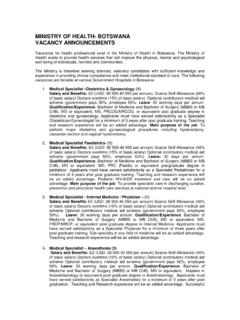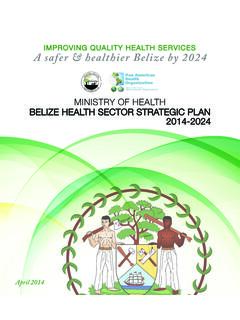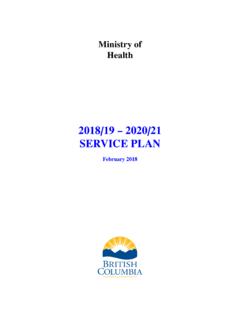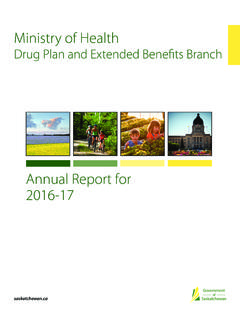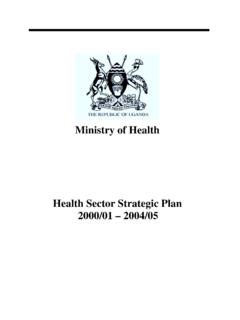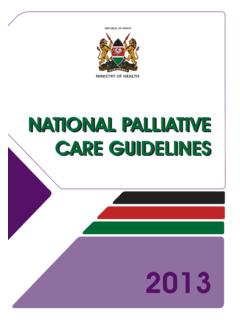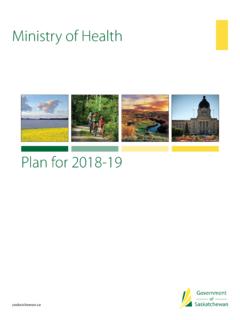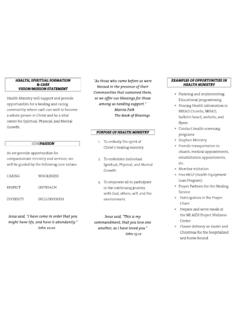Transcription of THE UNITED REPUBLIC OF TANZANIA MINISTRY …
1 THE UNITED REPUBLIC OF TANZANIA . MINISTRY OF health . Second health Sector Strategic Plan (HSSP). (July 2003-June 2008). Reforms towards delivering quality health services and clients satisfaction . MINISTRY of health TANZANIA APRIL 2003. Table of Contents Page Abbreviations ii Foreword v Acknowledgement .. vi Background Information vii Introduction 1. Section 1 - Principle 4. Section 2 New Developments/ Context 5. Section 3 Overview of Progress and Situation Analysis (1999 2002) . 8. Section 4 - health Sector Strategic Plan Framework 15. Section 5 - Implementation Arrangements 20. Section 6 - health Sector Strategic Plan (2003-2008).
2 22. Section 7 - Financing the HSSP 51. Section 8 - Monitoring and Evaluation . 58. Volume II: Annexes of HSSP 2003 2008. Terms of Reference Situation analysis POW 1999-2002. National health policy 2002: objectives Matrix HSSP 2003-2008. Council Performance Indicators References Map of TANZANIA showing regions and districts i i Abbreviations: AIDS : Acquired Immune Deficiency Syndrome AMMP : Adult Morbidity and Mortality Project ANC : Ante Natal Care ARV : Anti Retroviral (Drugs). BCC : Behavioural Change Communication BFC : Basket Financing Committee BOT : Bank of TANZANIA CA : Chief Accountant CAG : Controller and Accountant General CCHP : Comprehensive Council health Plans CHF : Community health Fund CHF : Community health Fund CHMT : Council health Management Teams CHSB : Council health Service Board CIA : Chief Internal Auditor CMO : Chief Medical Officer CNO : Chief Nursing Officer CSD : Civil Service Department CTU : Central Transport Unit DANIDA : Danish International Development Agency DAP : Directorate of Administration and Personnel DFID.
3 Department For International Development DHS : District health Services/Directorate of Hospital Services DPP : Directorate of Policy and Planning DPS : Directorate of Preventive Service DPT-HB : Diphtheria Pertusis Tetanus Hepatitis B (Vaccine). DRF : Drug Revolving Fund EC : Ethics Commission EPI : Expanded Programme on Immunisation FP : Family Planning FY : Financial Year GoT : Government of TANZANIA :Deutsche Gesellschaft fuer GTZ Technische Zusammenarbeit HAART : Highly Active Anti Retroviral Therapy HBS : Household Baseline Survey HIV : Human Immune Deficiency Virus HMIS : health Management Information System HMT : Hospital Management Team ii HR : Human Resources HRD : Human Resources Development HSD : Medical Stores Department HSPS : health Sector Programme Support HSR : health Sector Reform HSRS.
4 health Sector Reform Secretariat HSSP : health Sector Strategic Plan IMCI : Integrated Management of Childhood Illnesses IMR : Infant Mortality Rate KCMC : Kilimanjaro Christian Medical Centre Kfw : Kreditanstalt fuer Wiederaufbau LGA : Local Government Authorities LGR : Local Government Reform LHRC : Legal Human Rights Commission MCDGC : MINISTRY of Community Development, Gender and Children MCH : Maternal Child health MLDW : MINISTRY of Livestock Development and Water MLYD : MINISTRY of Labour and Youth Development MMR : Maternal Mortality Rate MOF : MINISTRY of Finance MoH : MINISTRY of health MOI : Muhimbili Orthopaedic Institute MOJCA : MINISTRY of Justice and Constitutional Affairs MTEF : Medium Term Expenditure Framework MTEF : Medium Term Expenditure Framework MTP : Medium Term Plan MTUHA : Mfumo wa Taarifa za Uendeshaji Huduma za Afya NACP : National Aids Control Programme NGO : Non-Governmental Organization NHIF : National health Insurance Fund NIMR : National Institute of Medical Research NORAD : Norwegian Agency for Development NSS : National Site Surveillance NTLP : National Tuberculosis and Leprosy Programme ORCI : Ocean Road Cancer Institute PCB.
5 Prevention of Corruption Bureau PER : Public Expenditure Review PLWHA : People Living With HIV/AIDS. PMO : Prime Ministers Office PMTCT :Prevention of Mother to Child Transmission POA : Plan of Action Presidents Office, Regional Administration and Local PORALG Government POW : Programme of Work PRSP : Poverty Reduction Strategy Paper iii RAS : Regional Administrative Secretary RHMT : Regional health Management Teams RS : Regional Secretariat SD : Standard Deviation STI : Sexual Transmitted Infections SWAp : Sector Wide Approaches SWOT : Strength, Weaknesses, Opportunities, Threats TACAIDS : TANZANIA Aids Commission TB : Tuberculosis TEHIP : TANZANIA Essential health Intervention Project TFNC.
6 TANZANIA Food and Nutrition Centre TOR : Terms of Reference UHP : Urban health Project USD : UNITED States Dollar iv v vi 1. Background Information health in TANZANIA health and Nutritional Status TANZANIA has achieved high rates of coverage of antenatal care (90%), immunization (DPT3. 87%-in 2001) and vitamin A supplementation (over 90%-in 2002). 68% of the households use iodised salt. The contraceptive prevalence rate has doubled since 1991-92, from 10 to 22% of all women. Measles, which used to be a common cause of child death, has been effectively contained. Despite these impressive gains, the general health and nutritional status of the population of TANZANIA remains poor.
7 Trends in the decline of infant (99/1000) and under-five (158/1000) mortality, which had been steady between the mid-1950s and mid-1980s stagnated and are being reversed. About one quarter of all under-five deaths occur within the first month and two-thirds within the first year after birth. TANZANIA is not on track to meet the 2015 targets of reducing under-five mortality by two thirds unless urgent actions are taken. Approximately 90% of all child deaths are attributable to common and preventable illnesses such as malaria, pneumonia, diarrhoea, malnutrition, HIV/AIDS and complications of low-birth-weight.
8 Eight out of ten children die at home and six of them without any contact with formal health services. There are large disparities between rural-urban, and various income quartiles with the rural poor being the most disadvantaged. Malnutrition rates are unacceptably high among children and women. About 16 percent of Tanzanian children are born with low birth weight (below 2500 grams). Low birth weight has a greater risk of continued under-nutrition and mortality in the first year of life, and pre-disposes children to chronic diseases (such as heart disease, and diabetes) during adulthood (Barker et al.)
9 , 1989). Low birth weight is also a proxy indicator of maternal deprivation, thus perpetuating the inter-generational cycle of deprivation and malnutrition. The onset of malnutrition starts soon after birth, and peaks by 12-18 months of age. 44% under-five children are stunted (implying significant chronic malnutrition) and 30% under weight. Rural- urban differentials are pronounced, the rural poor being the most disadvantaged. Malnutrition rates that were on the decline in 1980s have remained largely stagnant in the 1990s. Food insecurity, inadequacies in the frequency of feeding and micronutrient deficiencies (iron, iodine, and vitamin A), and frequent illness predispose children to high risk of malnutrition.
10 Micronutrient malnutrition is rampant among women, about 14% in the high land and nearly 80% in coastal areas are anaemic during pregnancy, and nearly 70% are vitamin A deficient. About 25% of maternal deaths are associated with anaemia. Maternal health Nearly 9000 women in TANZANIA die annually due to pregnancy related causes, (MMR=529 per 100,000 live births) and another about 250,000 women become disabled due to the same causes, seriously compromising their reproductive health . About 26% adolescent girls have their first birth by the age 19 years. (source) HIV/AIDS. Too early and too frequent pregnancies have additional risk to maternal illness and deaths.

